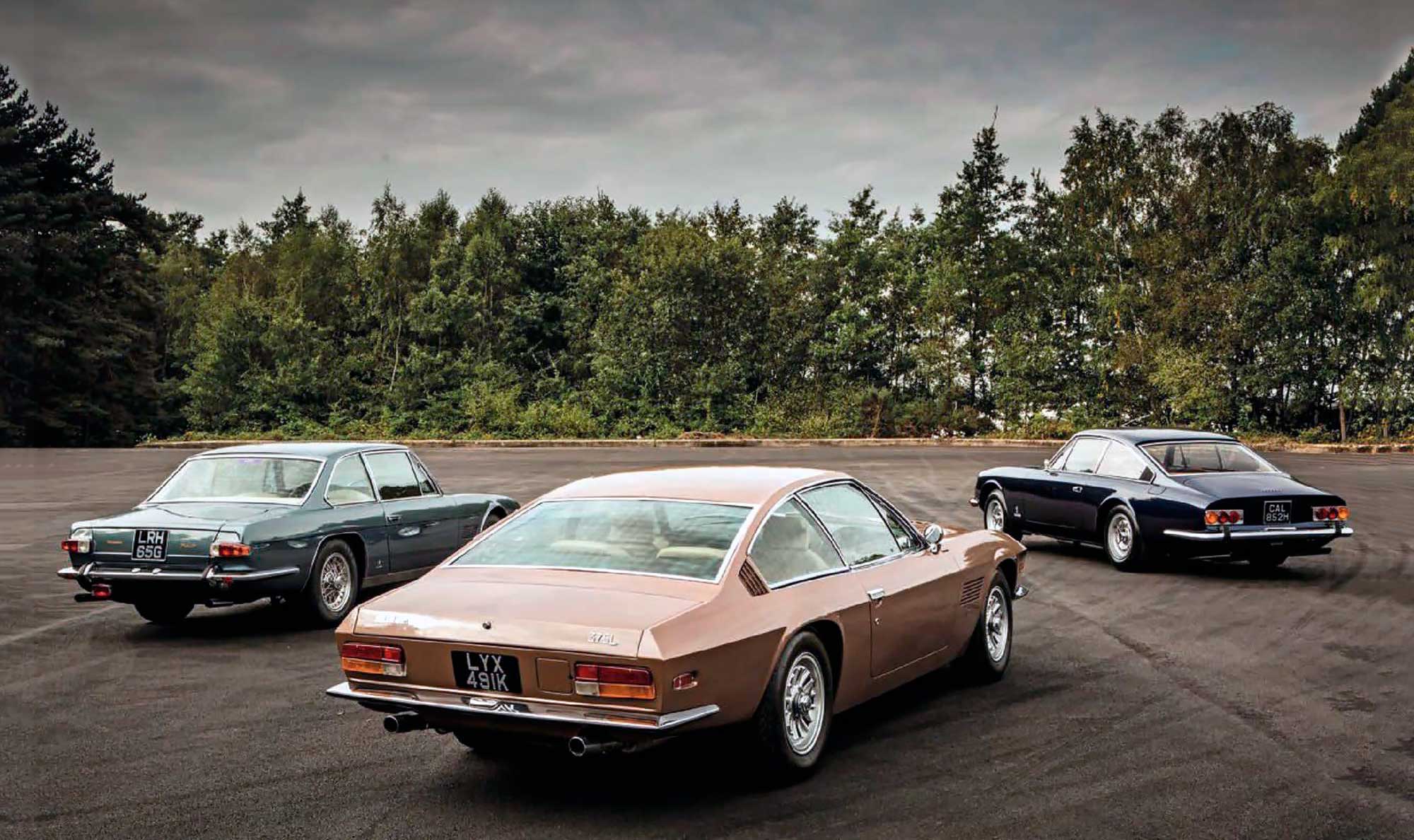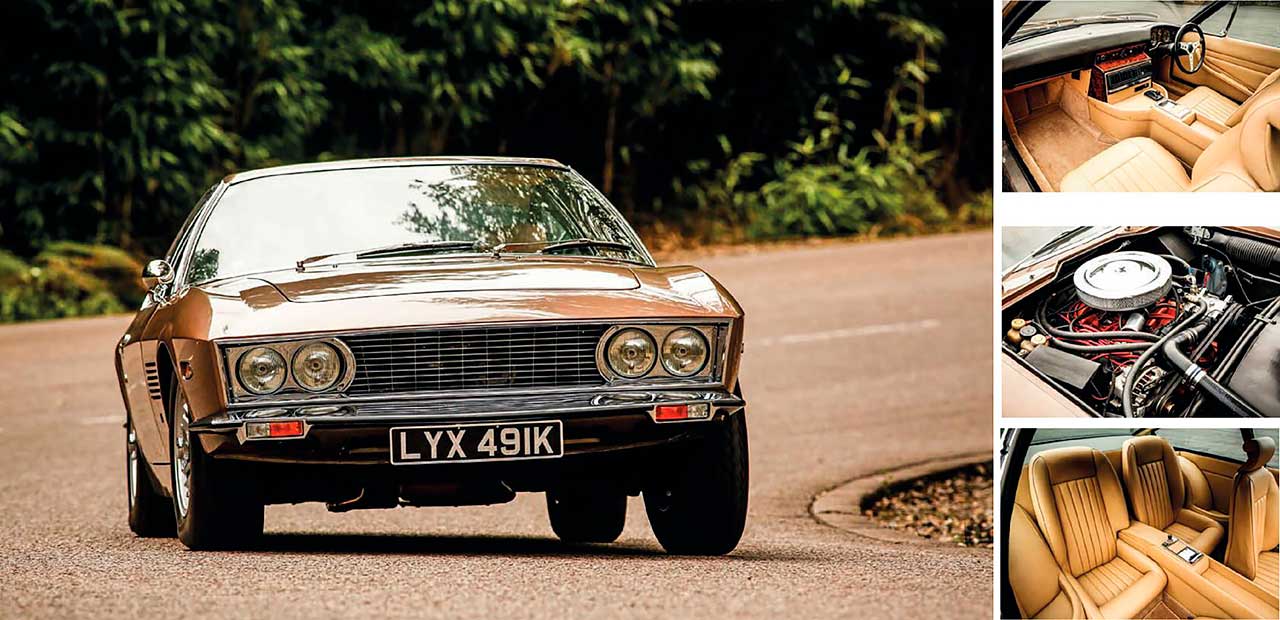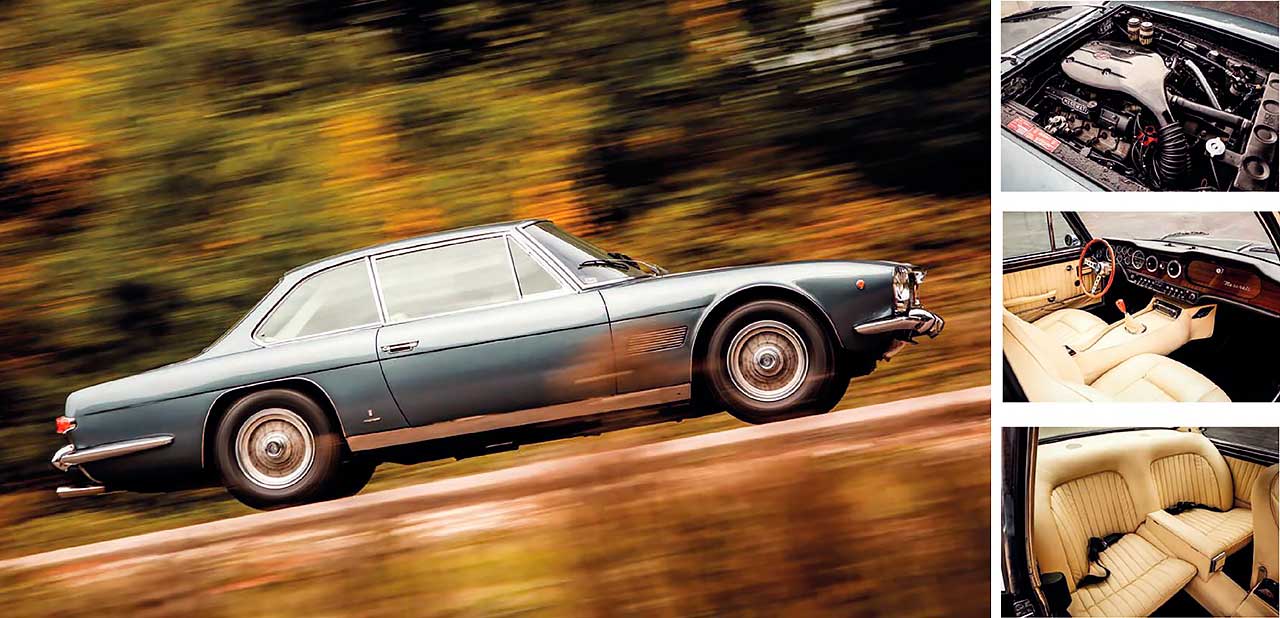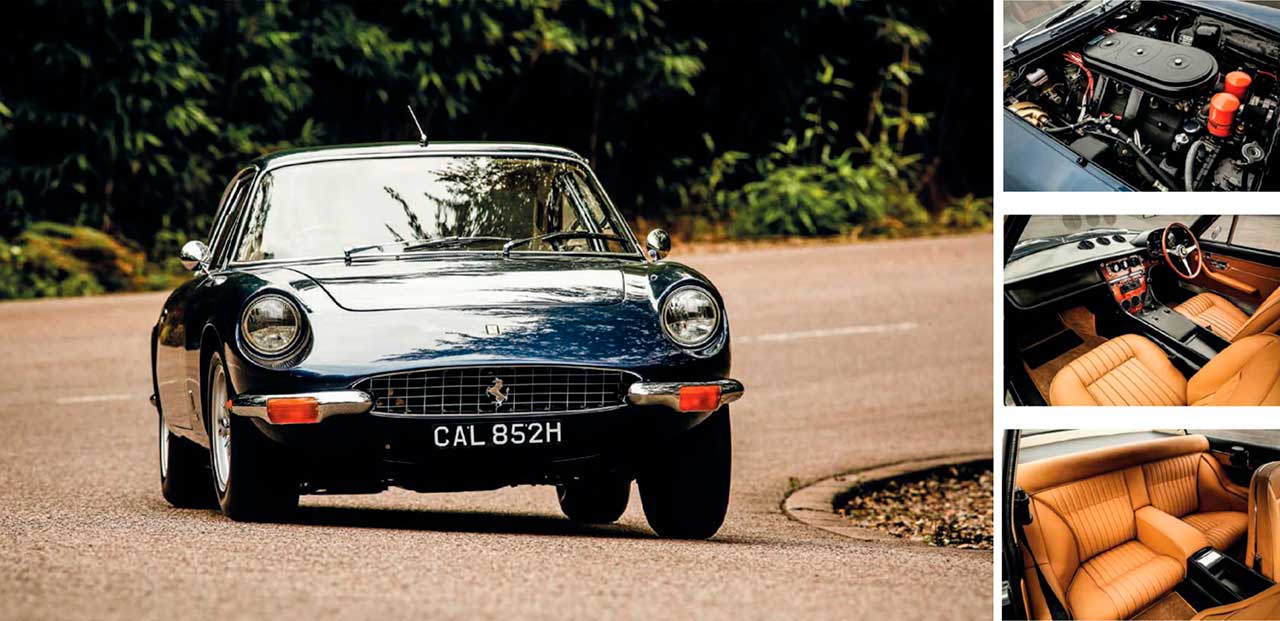
Grand Turismo greats Ferrari 365GT 2+2 takes on Maserati Mexico and Monteverdi 375L. Welcome to the jet set. Martin Buckley chooses between three exotic GTs with epic performance and svelte looks: the Monteverdi 375L, Maserati Mexico and Ferrari 365GT 2+2. Photography Tony Baker.
FERRARI 365 vs GT RIVALS
Peter Monteverdi’s big-block Chrysler-engined GT cars were the natural successors to Facel Vega and have a similar mythology around them – largely based on sheer scarcity. Nobody really knows how many were built between 1967 and ’1976, which adds to the mystique, and to speculate publicly can still attract the ire of those who seek to keep the Monteverdi flame alive. Even today, getting reliable production figures out of the secretive museum – located on the site of the former factory in Basel – is notoriously difficult. What we can say is that the total is probably a lot lower than you might think, few enough to make even a Facel Vega look positively common.

Each car features a more angular rear than their respective front ends would suggest. Note the similarity in the rear roofline between the Monteverdi and Ferrari.
So when a Monteverdi High Speed 375 comes up for sale on the open market it is something of an event, particularly when the car in question is one of the six right-hookers sold new in the UK.
Priced in period at £10,450 (the same as a Mercedes-Benz 600 W100) it’s easy to appreciate why they didn’t exactly fly out of the door. The featured 375L was sold new to John Entwistle, bass player in The Who. An eye-watering £235,000 will now capture it after a restoration that almost certainly ran into six figures over nearly as many years. That makes it, today, one of the most valuable Euro-American cars of its era, but then it’s as spectacularly elegant as it is deliciously rare.
It’s tempting to compare the 375L to a Jensen, an Iso or one of the other hybrid GTs, but to do so would perhaps underplay Monteverdi’s ambitions. This former racing driver and Swiss Ferrari agent was no fool and, having fallen out with Enzo Ferrari in a business deal, was looking to steal some of his thunder. Deploying practical, proven but sophisticated engineering, Monteverdi intended to build the world’s best high-performance luxury car.
Where other car-company bosses delegated, Monteverdi designed his dream GT himself, conceiving a jig-welded, 3mm-gauge rectangular- section tubular chassis, its Chrysler Magnum V8 mounted well back to give a low polar moment of inertia. He tied down the Salisbury limited-slip differential with a de Dion tube and then shopped around for what he considered to be the best in brakes and steering.

Clockwise: Monteverdi’s shape was finalised by the company founder; acres of leather, but the driving position is compromised – especially for tall drivers; bulletproof 7.2-litre Chrysler V8; rear seats are surprisingly habitable.
TECHNICAL DATA MONTEVERDI 375L
Sold/number built 1969-’1976/unknown
Construction steel chassis and body
Engine cast-iron, overhead-valve, 7206cc 90º V8, with single Carter carburettor
Max power 375bhp @ 4600rpm
Max torque 481lb ft @ 3200rpm
Transmission three-speed automatic, driving rear wheels
Suspension: front wishbones, coil springs, anti-roll bar rear de Dion axle, Watt linkage, trailing arms; telescopic dampers f/r
Brakes discs, with servo
Steering power-assisted ZF worm and roller
Length 15ft 4in (4673mm)
Width 5ft 11in (1803mm)
Height 4ft 2in (1270mm)
Wheelbase 8ft 9in (2667mm)
Weight 3665lb (1662kg)
0-60mph c6 secs
Top speed 147mph
Mpg 11
Price new £10,450
Price now £235,000
Automobile Monteverdi AG started promisingly with the beautiful Frua-styled 375S, but it quickly established that success lay not in the headline-grabbing two-seaters but in the realm of the 2+2 coupé. Thus, the S of 1967 begat the four-place L of 1969.
Whereas the 375S had been styled and coachbuilt by Frua, the longer 375L bodies were built by Fissore in Turin to a Frua design personally modified by Herr Monteverdi. It seems that Pietro Frua took the marque founder to court (and won) over his refusal to pay him the licensing fee on the original fastback design. Luckily, Monteverdi had a great eye for proportion.
The production 375L was, if anything, better looking than the 1968 Frua version, with a simple, clean roofline and a pert notchback. There was an entire family of Chryslerengined 375 Monteverdi High Speed models but the L became the backbone of the range. If there is such a thing as a ‘common’ Monteverdi, this is it. But whereas this is the only variant most people know about, the 365GT 2+2 is the 1960s Ferrari that seems to be most easily confused with something else, although like all older Prancing Horses the fortunes of this once-unloved model are on the up.
Fifty-two were built in right-hand drive, which was probably a record for Ferrari at the time, underlining the fact that the 365GT 2+2 was an important car. Launched at the Paris Salon in 1967, it represented a coming of age for the firm’s financially vital four-seaters – since the launch of the 250GTE in 1960, they’d been consistent best-sellers.
The 365GT 2+2 shared its wheelbase and basic welded tubular chassis, but not much else, with the outgoing 330GT. It had a wider track, a bigger 4.4-litre V12 and, most significantly, independent rear suspension for the first time on a 2+2 Ferrari. It was similar in concept to the 275GTB and 330GTC, but with self-levelling struts developed in conjunction with Koni to keep the tail height constant. With its standard ZF power steering and air-conditioning, this was the most refined Ferrari yet. Through to 1971, it would sell to the tune of 800 cars, or 50% of Maranello’s road-car output.
In the rarefied world of high-end Grand Touring cars, the Maserati Mexico was a comparable success, with 485 examples sold between 1966 and 1972. In fact, Maserati was, at the time, the world’s most successful GT builder, fielding a range of straight-six and V8 models for every rich man’s whim. Where Ferrari stayed loyal to Pininfarina, Maserati spread its bets across a variety of coachbuilders in the 1960s and early ’70s, constructing the cars around conservative but trusted components.
The Mexico, with its live rear axle and rugged semi-monocoque of welded box sections, was the firm’s sober two-door, four-seater offering, a quietly elegant Vignale-bodied sister car to the four-door Quattroporte. It was powered by a 4.2- or 4.7-litre wet-liner V8 derived directly from the 450S/5000GT but with chain drive for the cams, a wet sump and single-plug heads.

Clockwise: Mexico’s Vignale shape is more squared-off than the other two; beautifully appointed cabin; 4.2-litre quad-cam V8 engine offers plenty of smooth power; headroom is a little tight in the rear seats.
TECHNICAL DATA MASERATI MEXICO
Sold/number built 1966-’1972/485
Construction box-section steel chassis with steel body
Engine all-alloy, dohc-per-bank, 4136cc 90º V8, four twin-choke Weber carbs
Max power 290bhp @ 5000rpm
Max torque 282Ib ft @ 3800rpm
Transmission five-speed ZF manual, driving rear wheels
Suspension: front independent, by double wishbones, coil springs rear live axle, semielliptic leaf springs, radius arms; telescopics
Steering recirculating ball
Brakes discs, with servo
Length 15ft 6in (4724mm)
Width 5ft 7in (1702mm)
Height 4ft 5in (1350mm)
Wheelbase 9ft (2743mm)
Weight 4034Ib (1830kg)
0-60mph 8 secs
Top speed 150mph
Mpg 14
Price new £9765
Price now £90-£135,000
Mexicos came with air-conditioning, tinted glass and electric windows as standard (as they should have for £9765 circa 1970) but whereas the Monteverdi was supplied only as an automatic – and the Ferrari just as a manual – there was a choice of five-speed ZF or Borg Warner automatic with the Tipo AM112.
The featured 1968 4.2-litre Mexico is handsome and well proportioned on its Borrani wire wheels. It wears the jewellery of its slim bumpers and chrome sill finishers so lightly that you hardly notice the clumsy rear lights and awkwardly squared-off rear arches.
To enter, you grasp what looks like a Fiat doorhandle and climb into a highly detailed leather interior with neatly pleated doorcards and headlining, glossy rosewood veneers, sevendial instrumentation and flick switches that range across the dash like tiny Guinness bottles. Snuggle into the driver’s seat and you’re confronted with a steering wheel that sits in your lap, chunky foot pedals, the biggest sunvisors I have ever seen and a tiny rear-view mirror.
Smokers are well catered for with three ashtrays plus two lighters. In the rear – sitting on a very Interceptor-like sculpted bench – you feel the lack of headroom rather than legroom.
Thankfully, this Mexico is a manual (the auto tended to go into the 4.7s), so you can make the best of the engine’s sweet spot in the 2000- 4000rpm range. The clutch is light and a bit indistinct in feel, the change meaty and satisfying – if not exactly slick. The Mexico punches forward with a huskily refined sound of humming cam chains and whooping Webers that is unique to this most cultivated of V8s. It shoots to 5000rpm if required, but 4500rpm is enough to get you to an easy 100mph where the firmly damped ride has long since smoothed out and the sharp brake feel seems to make more sense. That said, your angle of attack on the hefty throttle feels somewhat unnatural.
Inexplicably, however, the steering is awful: light and disconnected, leaving you with no sense of load. Its only saving grace is an impressive lock. Not until afterwards did I find out that this Mexico had an electric power steering conversion for those wimpy modern motorists who can’t deal with the hefty unassisted original.
The 365GT 2+2 was the first Ferrari with power steering and it steers beautifully, but we will get to that later. In looks, it is part-500 Superfast, part-365 California Spider, the pouting and curvaceous nose not quite at ease with its angular tail. It has presence, authority and dignity but falls somewhere short of real beauty.
In some ways, the Ferrari makes up for this in the sheer attention to detail. The bullet-shaped doorhandles and triple-shot rear lights, for example, don’t immediately strike you as having come off something more humble.
Inside, the handsome dashboard architecture has echoes in a variety of Fiats and Lancias of the early 1970s. The commanding instrument binnacle (very like one of my old Lancia 2000s, in fact – as is the ribbed, padded headlining) and the array of toggle switches seem to tell you that somebody at Maranello thought about the design of this interior quite deeply, rather than dashing it off after a heavy lunch.
The V12 fires rapidly on the aggressivesounding starter motor and there’s an insistent blue light on the dash to say that the Autoflux (for priming the carburettors) is on. The singlecam- per-bank unit responds to the tiniest movement of the long, smooth throttle and you can potter the Ferrari around as if it were being pushed along by a giant turbine.
There are no pauses in the delivery of power, although real pull doesn’t start until you begin piling on the revs. It will shoot to 6000rpm in one strong, seamless lunge, with 50mph coming up in first and the other four ratios delivering 25mph each until you top out, in theory, at the 2+2’s maximum speed of 150mph.
It sounds quicker than it really is, but you can’t help being impressed, and that’s what matters. The blood races, your spine tingles and no matter how hard you try to remain objective there is something in the sound and feel of the 365GT 2+2 that lives up to every hoary cliché you ever read about old Ferraris.
The beautiful steering wheel is a hand’s span away from the assertive-looking gearlever, but the man-sized suspended pedals are slightly offset to the left. The clutch is smooth and light in action, the brakes strong and you can play easy tunes on the gearbox with its positive spring-loaded centring action.
And, as I say, the power steering is superb. You can’t knock it for lack of feel and once under way you would never know it was powered. That means you can take unexpected liberties with the 365 2+2’s handling.

Clockwise: gorgeous front end echoes the 500 Superfast; elegant interior is well thought-out and full of character; famous V12 powerplant makes an intoxicating noise; heavily sculpted rear seats.
TECHNICAL DATA FERRARI 365GT 2+2
Sold/no built 1967-’1971/800
Construction steel tubular chassis with steel and alloy body panels
Engine all-alloy, sohc-per-bank 4390cc 60º V12, three twin-choke Weber carbs
Max power 320bhp @ 6600rpm
Max torque 267Ib ft @ 5000rpm
Transmission five-speed manual, driving rear wheels
Suspension independent, by wishbones and coil springs front anti-roll bar rear self-levelling dampers
Steering power-assisted ZF worm and roller
Brakes Girling discs all round, twin circuit with servo
Length 16ft 4in (4890mm)
Width 5ft 10in (1790mm)
Height 4ft 5in (1345mm)
Wheelbase 8ft 8in (2650mm)
Weight 3487Ib (1580kg)
0-60mph 7.1 secs
Top speed 150mph
Mpg 14
Price new £8563
Now £150-£300,000
This is not a transaxle Ferrari like the GTBs and GTCs but it feels balanced, neutral and forgiving for such a hefty machine. It is also the only one of this set that you feel you can get straight into and find its limits enjoyably.
Undoubtedly there is a story to be told about the influence of chief development engineer Mike Parkes on this generation of Ferrari road cars. The Monteverdi is without question a chariot of the gods – shark-nosed and slim-hipped, with a svelte swagger about it and a cachet of exclusivity that is unmatched among its Euro-American peers. From the outside, it accelerates away with just the right sort of brutish yet somehow cultivated throatiness you expect from a car that looks like this, while its bold quad-headlight front end fills a mirror like almost nothing else.
On the other side of its steeply raked windscreen, however, the problems start with the driving position. This is one of those cars where the designer forgot that people come in a range of sizes, so unless you are rather short (like Mr Monteverdi, funnily enough), you feel that the top of the ’screen is much too close to your forehead.
Moreover, the absurdly lengthy steering column pokes out of the dashboard at an uncompromisingly horizontal angle (which puts the steering wheel in your lap) and the massive centre console offsets the pedals so that your arms and legs feel as if they are pointing in different directions.
The 375L dash is pleasing if you are willing to ignore the details borrowed from BMW and Mercedes, which is inevitable and doesn’t really matter. Generally, the cabin lacks the attention to detail found in the Italian cars, but the rear seats look less of an afterthought than the others and, front or rear, there is a delightful impression of airiness in the Monteverdi.
‘YOU CAN POTTER THE FERRARI AROUND AS IF YOU’RE BEING PUSHED BY A GIANT TURBINE’
The engine, with its huge fan shroud and lurid orange tappet covers, dominates the car’s personality. It has the instant torque that just snaps the Monteverdi off the line and shoves it up the road on two gearchanges, each flicking through smoothly with minimal slur and slip.
The fascination of its performance is that you don’t have to work hard for it, and any kickdown activity or gear-selector antics amount to superfluous tomfoolery. Windows up, it floats along serenely at three figures, very stable and steady. The pay-off for mounting the engine so far back – thus compromising the driving position so badly – is that the 375L does not feel its weight in corners, steers surprisingly neutrally and has less of a sensation of body roll from the inside than it displays on the outside.
But, in the end, it’s no Ferrari, or even a Maserati. Rather, it feels like an intriguing collection of bits that never quite add up to their sum, or to the promise of its styling. In contrast, the 365 behaves the way it does because it is an engineering entity, the influence of each component balanced against the other to produce a car that was the carefully considered result of 30 years of experience.
The likeable Mexico is a gentlemanly machine – special enough to be covetable but not so finicky that you couldn’t live with it – that has something of the appeal of both Ferrari and Monteverdi. Today, at £135,000 it is the bargain of this trio, although in a world where buyers might be more image- than price-sensitive its appeal could be too subtle for some people.
Which to choose? I’m going to cop out and say I could think of good reasons for owning all of them. But then again, how often do you get the chance to buy a Monteverdi?
Thanks to DD Classics, which is selling the Monteverdi and Maserati: ddclassics.com; Foskers, which is selling the Ferrari: foskers.com
{CONTENTPOLL [“id”: 86]}





